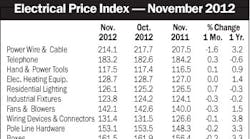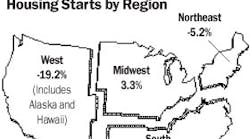Latest from Mag
People - Dec 21, 2012
Obituaries - Dec 21, 2012
November EPI Index Shows No Change
Housing Starts Dip 4% in November
Electrical Marketing - December 21, 2012
Around the Industry - Dec 21, 2012
Fourth-Quarter GDP Increased from Third Quarter
+5.8%
In late April, the U.S. Commerce Department issued its advance estimates for the first-quarter 2002 growth in GDP (Gross Domestic Product — the output of goods and services produced by labor and property located in the United States). GDP increased at an annual rate of 5.8 percent in the first quarter of 2002, according to advance estimates released by the Bureau of Economic Analysis. In the fourth quarter, GDP increased 1.7 percent. The major contributors to the increase in real GDP in the first quarter were: private inventory investment, personal consumption expenditures, government spending, residential fixed investment and exports. The contributions of these components were partly offset by a decrease in nonresidential structures. Imports, which are a subtraction in the calculation of GDP, increased. The acceleration of real GDP growth in the first quarter primarily reflected upturns in private inventory investment, in exports, and in residential fixed investment and smaller decreases in nonresidential structures and in equipment and software that were partly offset by a deceleration in PCE.
Index of Leading Economic Indicators Increased in March
+0.1%
The Conference Board's Index of Leading Economic Indicators, designed to predict economic patterns over the next few months, increased by 0.1 percent in March. The leading index now stands at 112.3. The coincident index increased by 0.2 percent to 116.0 (1996=100). The lagging index, an indication of where the economy has already been, fell 0.4 percent in March. The leading index has been posting strong gains, growing by 2.9 percent from September 2001 to March 2002, and by 2.2 percent for each of the six-month periods ending January and February 2002. The gains would have been more robust had it not been for the weakness in building permits and claims for unemployment insurance.
Six of the 10 indicators that make up the leading index increased in March. The positive contributors to the leading index — from the largest positive contributor to the smallest — were average weekly manufacturing hours, stock prices, interest rate spread, index of consumer expectations, vendor performance, and manufacturers' new orders for consumer goods and materials. The four negative contributors to the index — beginning with the largest negative contributor — were building permits, average weekly initial claims for unemployment insurance (inverted), real money supply and manufacturers' new orders for nondefense capital goods.
The markets tend not to react to this index, but it's important because it paints a broad picture of the economy and it can signal trends. Because it consists of 10 equally weighted indicators, it has low volatility. Three consecutive months of decline in this indicator may signal a downturn in the economy.
U.S. Trade Deficit Increased in February
+11.7%
The nation's international deficit in goods and services increased to $31.5 billion in February, from $28.2 billion (revised) in January, as imports increased more than exports. Exports increased $1.0 billion from January to $79.2 billion. Imports increased $4.2 billion from January to $110.7 billion. Goods were $92.1 billion in February, up from $88.8 billion in January, and services were $18.6 billion in February, up from $17.7 billion in January.
Purchasing Managers' Index Decreased in April
-1.7 Pts.
Economic activity in the manufacturing sector grew for the third consecutive month in March. Meanwhile, the overall economy grew for the sixth consecutive month, according to the Institute for Supply Management, Tempe, Ariz., which compiles the Purchasing Managers' Index (PMI). The PMI stood at 53.9 percent in April, a decrease of 1.7 percentage points from the 55.6 percent reported in March. A reading above 50 percent indicates that the manufacturing economy is generally expanding; below 50 percent indicates that it is generally contracting.
Norbert J. Ore, C.P.M., chair of the Institute for Supply Management's Manufacturing Business Survey Committee and group director, strategic sourcing and procurement, Georgia-Pacific Corp., said, “Though the rate has slowed, a third consecutive month of growth in the manufacturing sector is certainly encouraging. The New Orders Index lost some momentum, but it is still strong enough to drive sector growth in the next several months.”
Of the 20 industries in the manufacturing sector, 18 industries reported growth: textiles; glass, stone and aggregate; petroleum; furniture; primary metals; fabricated metals; rubber and plastic products; miscellaneous (a preponderance of jewelry, toys, sporting goods, musical instruments); transportation and equipment; instruments and photographic equipment; wood and wood products; tobacco; printing and publishing; electronic components and equipment; chemicals; paper; food; and industrial and commercial equipment and computers.
“The overall picture shows growth in manufacturing activity during April,” added Ore. “The PMI indicates a third consecutive month of significant growth. This month the Prices Index continued to make a strong move upward, indicating pricing power in some commodities. Energy is still a concern for many buyers. Textiles, primary metals, and instruments and photographic equipment appear very aggressive in hiring at this point.”
Consumer Confidence Declines Moderately in April
-1.9 Pts.
The Conference Board's Consumer Confidence Index, which surged in March, declined moderately in April. The index now stands at 108.8, (1985=100), down from 110.7 in March. The Present Situation Index rose from 111.5 to 107.0. The Expectations Index declined from 110.2 to 110.0.
“This month's retreat in confidence was caused primarily by a softening in consumers' assessment of current economic conditions,” said Lynn Franco, director of The Conference Board's Consumer Research Center. “Consumers' expectations remain virtually undaunted and signal continued expansion in the months ahead.”
Durable-Goods Orders Increased in March
+0.4%
New orders for manufactured goods (excluding semiconductors) in March increased $1.4 billion or 0.4 percent to $318.5 billion, the Department of Commerce, Bureau of the Census reported today. This followed a 0.2 percent February increase. Year to date, new orders for 2002 were 5.5 percent below the same period a year ago; new orders for the first quarter were 0.3 percent below the fourth quarter. Shipments (excluding semiconductors) increased $2.3 billion or 0.7 percent to $317.5 billion, following a 2.9 percent February decrease.

